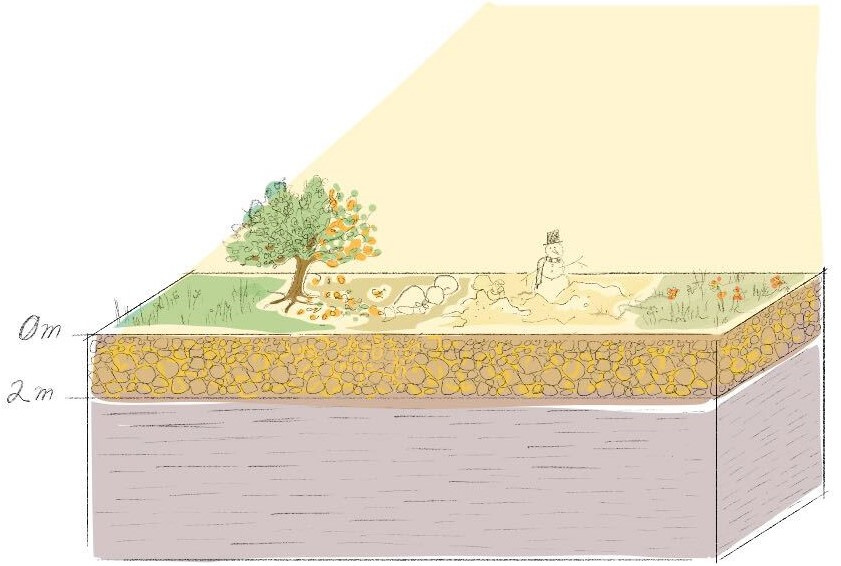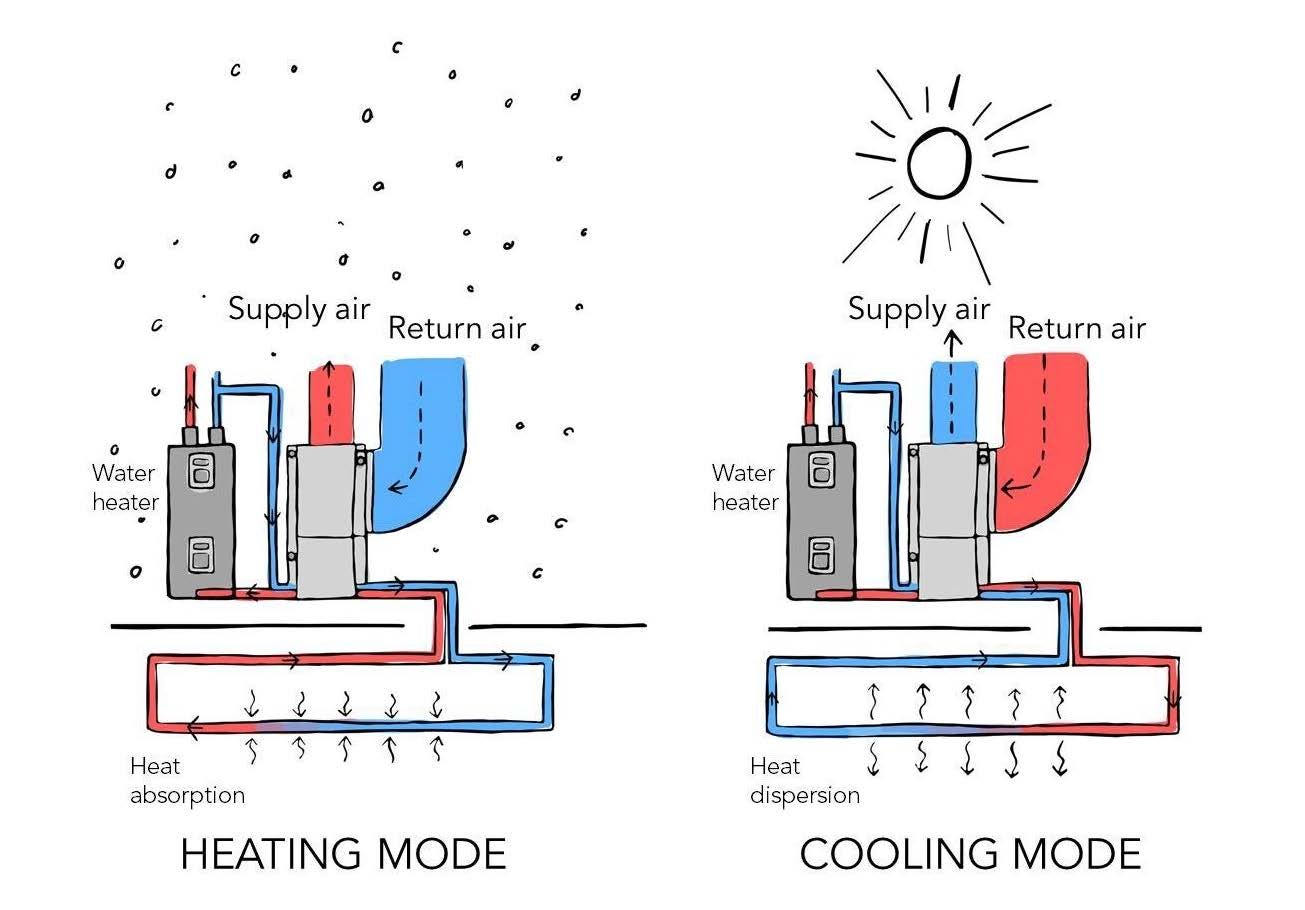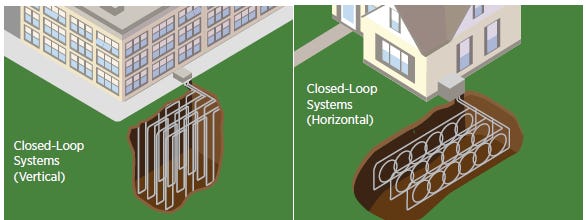Let's Talk Geothermal Heat Pumps
Learn more about an amazing and underutilized technology that you could use to help improve our communities... And fight climate change.
Geothermal heating and cooling systems are one of the most versatile and poorly understood climate solutions. They have been used since the 1940s for keeping a building’s temperature steady, but are relatively unknown as an alternative to fossil fuel-run heating and cooling systems. Regardless, geothermal heat pumps have a ton of potential and it’s past time to shine some light on this revolutionary technology.
Climatescape is going to VERGE 2022! If you want to meet the teams building our sustainable future, follow along as we share exclusive live coverage, October 25-27.
Combating Weirding Weather

In the face of climate change, people are suffering from an abundance of seasonal problems. From over 100°F summers in Vancouver to the energy crisis in Europe as a brutal winter approaches, the planet is facing unusual and dangerous temperature swings.
In the EU, over 70% of the total energy consumption goes to space heating. Meanwhile, in the U.S., more than half of the energy used in homes is for space heating and air conditioning. While slightly lower, heating and cooling can make up over 15% of electricity use in commercial buildings.
Global communities need to start integrating sustainable heating and cooling technologies that require fewer fossil fuels and electricity to function, while keeping people comfortable more consistently. Geothermal heat pumps could be the answer.
Pumping Heat from the Ground
Have you ever been to a cave or lava tubes? Despite changing seasons, you’ll always experience about same temperature inside the cave. In the summer, the cave will feel cooler than the outside air—but in the winter, the cave will feel warmer. This is because the cave’s rocky walls protect the air inside from equilibrating to the air outside. It’s a great vacation spot from any weather!

As demonstrated by the cave, underground temperatures remain a mostly constant temperature, between 45°F (7°C) to 75°F (21°C). Geothermal heat pumps use this consistent heat to warm and cool a building. They can even be used to heat water!
How geothermal heat pumps work
Geothermal, or ground source, heat pumps use the Earth as both a source and sink. A series of pipes anywhere from 4 to 400 feet deep moves a water-coolant mixture from the heat pump into the ground and back again. Regardless of the season, the liquid carries heat from a heat source to a heat sink—what changes is which end of the system provides or absorbs the heat.

In the winter, the source of heat is from the ground, and the sink is the air. The liquid absorbs heat from the soil and brings it up to the heat pump. The heat pump then transfers that heat from the water to the building’s air, warming it up.
In the summer, the source of heat is the air in a building. The heat pump takes that heat, transfers it into the water-coolant mix, and pumps the heat underground. This cools the building down.
Simply put, geothermal heat pumps are very good at exchanging heat between two sources—one the ground, one the air. But why are they so good for mediating climate change?
A Better Earth-Based Energy
Geothermal heat pumps are a great tool for reducing energy consumption from heating and cooling.
Unfortunately, due to upfront cost, a lack of public awareness, and lukewarm government support, geothermal heating and cooling systems have remained underutilized for over eighty years.
Despite these barriers, what can geothermal heat pumps do for us?
Low Risk, High Reward
Besides digging up the soil around and underneath a building, geothermal ground loops are one of the least impactful on the environment. The holes are shallow, there’s no fracking, and they can be installed practically anywhere.
In fact, retrofitting buildings and prioritizing geothermal heat pumps could improve cities as we know it. Conventional cooling methods (like air conditioners) transfer heat from inside a building to the air outside, contributing to issues like the heat island effect. In contrast, a geothermal system transfers the heat underground, reducing the amount of heat added to the city’s environment.

Geothermal heat pumps let you have your ice cream and eat it too. They reduce both the cost and energy demands of heating and cooling a building by using the ground as a resource. While they are not a passive system, ground source heat pumps don’t need nearly as much electricity as conventional heating and cooling systems—between 20-40% less!
One of the only current downsides is that geothermal heating and cooling systems have a high upfront cost. With incentives and tax rebates, installations can range between $10 to $30 thousand.
Despite this initial cost, ground source heat pumps will save you money in the end. They can provide between 25-50% savings each year, returning that initial investment within 5-14 years. Plus, with more innovation in the industry, the savings will only get better!
Another huge (and perhaps obvious) benefit of geothermal heat pumps is the elimination of fossil fuels, which produce greenhouse gasses and other harmful emissions. Because ground source heat pumps use electricity and not fuel as their energy source, they produce 75-85% fewer CO2 emissions than conventional oil and gas systems.
Plus, as the grid gets more eco-friendly with solar, wind, nuclear, and (fingers crossed) geothermal electricity, you may find yourself off fossil fuels altogether, without even trying!
To learn more about other types of geothermal energy, check out our previous articles.
Flexible and Durable
Geothermal heating and cooling systems can be installed anywhere, from deserts to mountains, cities to rural homesteads. They can be used in all types of buildings, including hospitals, houses, offices, schools, and more.
Their flexibility is in part due to the fact they can be installed in various kinds of pipe configurations to accommodate land availability.
Horizontal configurations take up more horizontal space while vertical configurations go deeper. Horizontal configurations are generally easier and cheaper to install. They work best in houses, farms, hospitals, or industrial areas. Meanwhile, vertical configurations can be used for apartment complexes, urban offices, and other kinds of city buildings with more ground availability beneath them.
Geothermal heat pumps are also exceptionally durable. As long as they are installed correctly, a heat pump can last 20+ years, while the ground portion remains functional for up to 75 years—maybe longer.
A Game of Catch-Up
According to the U.S. Department of Energy’s GeoVision report, “75% of residential geothermal heat pump applications are in new construction and 25% are retrofits of existing homes. GHPs represent about 1% of the U.S. HVAC market.” Despite the fact this technology has been around for a while, it’s dragging its feet in sales.
In fact, geothermal heating and cooling has a market potential that’s 14 times larger than its existing capacity. With further technological innovation and cost reduction, we could see 23% of homes in the U.S. using ground source heat pumps by 2050. And if we push for it, we could get that number way higher.
However, this won’t be the case unless we can do three things:
Improve financial options for households and businesses to install these systems at a cost that doesn’t break the bank. We’re already seeing this happen due to the Inflation Reduction Act passed by the U.S. Government this year. The Act provides a 30% tax credit for geothermal heat pump projects constructed up until 2033. Learn more here.
Support technological advancements that can lower the cost of installation, as well as improve the efficiency of the heating and cooling system itself. Companies like Bedrock Energy (see below) are working on this problem directly.
Improve public support and understanding of geothermal heating/cooling systems. That’s where you come in. You’ve already taken the time to learn about geothermal heating and cooling systems—great job! But, what else can you do?
Take Action
It’s time to start asking questions and taking action. Geothermal heat pumps are one of those great climate tech opportunities that depend a lot on the individual.
Maybe you own a house or building—you have the power to install a geothermal heat pump on your property. Or you work at a company that should change how their offices are heated and cooled. You can even ask your local officials to retrofit government buildings with geothermal heat pumps, like the city of Ithaca in New York.
These are just a few ways that you as an individual can take action—because it takes individuals like you to push this industry forward.
Companies to Look Out For
Dandelion Energy
Dandelion Energy offers geothermal heating and cooling systems to homeowners in the Northeastern U.S. In the Northeast, single-family homes often still rely on dangerous propane or fuel tanks. Dandelion provides an alternative for these homeowners, saving them money in fuel bills.
In order to make the upfront cost more affordable, Dandelion offers financing over 10-12 year periods. Their approach reduces the reliance of fossil fuels in one of the most populated regions in the country.
Bedrock Energy
Based in Los Angeles, CA and Austin, TX, Bedrock Energy is looking to transform the heating and cooling of buildings using technologically advanced geothermal energy. They will radically reduce the cost of installation and the impact on the environment.
Cornell University Earth Source Heat
This past summer, Cornell University drilled a two-mile deep exploratory borehole to help researchers explore subsurface conditions and the thermal heat gradient. While deeper than a typical geothermal heating and cooling system, this project would too be used for warming the Cornell campus.
Did you like this article? Make sure to subscribe so you don’t miss any new content in the future!
Further Learning Materials
📺 Is Geothermal Heating and Cooling Worth the Cost? Heat Pumps Explained
This video goes over the intricacies of geothermal heat pumps, their pros and cons, and some groups innovating the industry.
📰 Choosing and Installing Geothermal Heat Pumps
The Department of Energy provides further information into finding financing, incentives, and companies for installing geothermal heating and cooling systems.
🧮 Geothermal Heating and Cooling Savings Calculator
WaterFurnace provides a fun (if not anxiety inducing) tool that gives you an idea of how much money you personally can save with a geothermal heating and cooling system.





